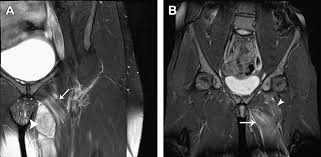Athletic pubalgia and sports hernia are debilitating groin pain syndromes that have become major focal points in the diagnosis and treatment of the professional athlete. The concept of a debilitating focal groin injury was first described by Gilmore in 1980 as a “groin disruption”. A variety of terms has been used to describe groin pain syndromes, including Gilmore’s groin, symphysis syndrome, hockey groin syndrome, adductor gracilis syndrome, occult inguinal hernia, sportsman’s hernia, and incipient hernia .
From a conceptual basis, athletic pubalgia is based on a biomechanical model, and sports hernia is best considered from an anatomical perspective. Athletic pubalgia is defined as an injury to the rectus abdominis insertion on the pubic symphysis, often accompanied by injury to the conjoined tendon insertion and the adductor longus attachment to the pelvis. The sports hernia is defined as an injury of the transversalis fascia leading eventually to incompetency of the posterior inguinal wall .


Clinical presentation:
Athletic pubalgia is a diagnosis of exclusion. Other more important causes of groin pain must first be ruled out. The symptoms are usually very non-specific and include:
- tenderness on palpation of the medial inguinal floor.
- tenderness on palpation over the pubic ramus.
- exacerbated pain with resisted hip adduction.
Radiographic features:
The preferential imaging modality for the diagnostic workup of ‘groin pain’ in athletes is MRI, however, some helpful imaging features can be observed in other imaging modalities.
Plain radiograph/CT
- degenerative changes
- alignment abnormalities
- widening of the symphysis
- assist in excluding other causes of groin pain e.g. osteoarthritis, femoroacetabular impingement

MRI
Osteitis pubis: subchondral bone marrow edema, involving the entire anterior-posterior diameter of the pubic bone as a result of an osseous stress response. Adductor tendon injury, injury or tear of the aponeurotic plate or a combination of all.
Furthermore, the objective of MRI in the evaluation of groin pain is not only to demonstrate pathologic findings of the pubic bone, the rectus abdominis-adductor longus aponeurotic plate and the adductor insertions but also to rule out or identify potential other causes of groin pain e.g. inguinal hernias and hip-related groin pain.
Treatment and prognosis:
Adductor-related groin pain can be treated with supervised active physical training, multimodal treatment including adductor manipulation or operatively with a partial release. Pubic related groin pain can be treated with a pubic symphyseal injection.
References:
- Radiopaedia
- eEjradiology.com
